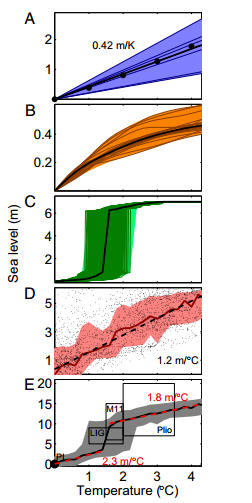If warming projections exceed estimates and rise by 1 degree Celsius, a new computer model finds that sea levels will rise about seven feet - over the next several thousand years.
But that would be duplicated for every degree of additional warmth as well.
The paper in the Proceedings of the National Academy of Sciences combined analyses of four major contributors to potential sea level rise into a collective estimate, and compared it with evidence of past sea-level responses to global temperature changes.
Estimates are that the four major contributors to sea-level rise on a global scale will come from melting of glaciers, melting of the Greenland ice sheet, melting of the Antarctic ice sheet, and expansion of the ocean itself as it warms. They merged different analyses into a single projection.
In their paper, the authors note that sea-level rise in the past century has been dominated by the expansion of the ocean and melting of glaciers. The biggest contributions in the future may come from melting of the Greenland ice sheet, which could disappear entirely, and the Antarctic ice sheet, which will likely reach some kind of equilibrium with atmospheric temperatures and shrink significantly, but not disappear.
"The study did not seek to estimate how much the planet will warm, or how rapidly sea levels will rise," noted Peter Clark, an Oregon State University paleoclimatologist and author on the PNAS article. "Instead, we were trying to pin down the 'sea-level commitment' of global warming on a multi-millennial time scale. In other words, how much would sea levels rise over long periods of time for each degree the planet warms and holds that warmth?"
"The simulations of future scenarios we ran from physical models were fairly consistent with evidence of sea-level rise from the past," Clark added. "Some 120,000 years ago, for example, it was 1-2 degrees warmer than it is now and sea levels were about five to nine meters higher. This is consistent with what our models say may happen in the future."
The researchers ran hundreds of simulations through their models to calculate how the four areas would respond to warming, Clark said, and the response was mostly linear. The amount of melting and subsequent sea-level response was commensurate with the amount of warming. The exception, he said, was in Greenland, which seems to have a threshold at which the response can be amplified.
"As the ice sheet in Greenland melts over thousands of years and becomes lower, the temperature will increase because of the elevation loss," Clark said. "For every 1,000 meters of elevation loss, it warms about six degrees (Celsius). That elevation loss would accelerate the melting of the Greenland ice sheet."

Sea-level commitment per degree of warming as obtained from physical model simulations of (A) ocean warming, (B) mountain glaciers and ice caps, and (C) the Greenland and (D) the Antarctic Ice Sheets. (E) The corresponding total sea-level commitment, which is consistent with paleoestimates from past warm periods (PI, preindustrial, Plio, mid-Pliocene; see text for discussion). Temperatures are relative to preindustrial. Dashed lines and large dots provide linear approximations: (A) sea-level rise for a spatially homogeneous increase in ocean temperature; (A,D,E) constant slopes of 0.42, 1.2, and 1.8 and 2.3 m/°C. Shading as well as boxes represent the uncertainty range as discussed in the text. (A–C) Thin lines provide the individual simulation results from different models (A and B) or different parameter combinations (C). The small black dots in Drepresent 1,000-y averages of the 5-million-year simulation of Antarctica following ref. 36. Credit: doi:10.1073/pnas.1219414110
In contrast, the Antarctic ice sheet is so cold that elevation loss won't affect it the same way. The melting of the ice sheet there comes primarily from the calving of icebergs, which float away and melt in warmer ocean waters, or the contact between the edges of the ice sheet and seawater.
"Keep in mind that the sea level rise projected by these models of 2.3 meters per degree of warming is over thousands of years," emphasized Clark, who is a professor in Oregon State University's College of Earth, Ocean, and Atmospheric Sciences. "If it warms a degree in the next two years, sea levels won't necessarily rise immediately. The Earth has to warm and hold that increased temperature over time.
"However, carbon dioxide has a very long time scale and the amounts we've emitted into the atmosphere will stay up there for thousands of years," he added. "Even if we were to reduce emissions, the sea-level commitment of global warming will be significant."
Citation: Anders Levermann, Peter U. Clark, Ben Marzeion, Glenn A. Milne, David Pollard, Valentina Radic, and Alexander Robinson, 'The multimillennial sea-level commitment of global warming', PNAS 2013 ; published ahead of print July 15, 2013, doi:10.1073/pnas.1219414110





Comments